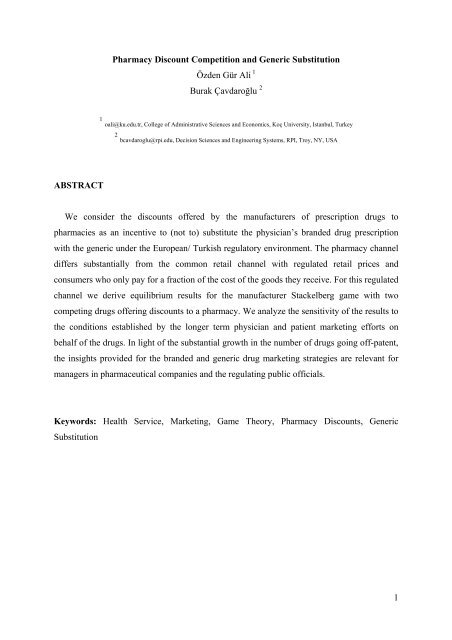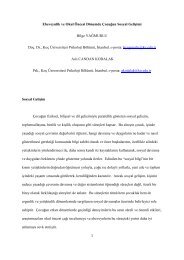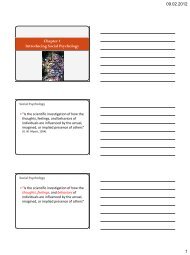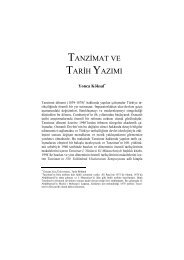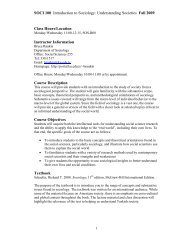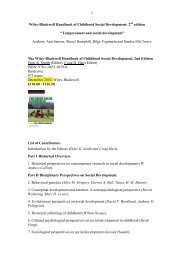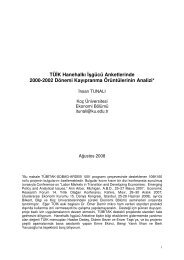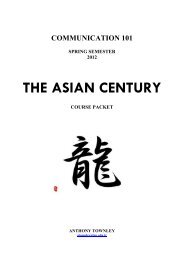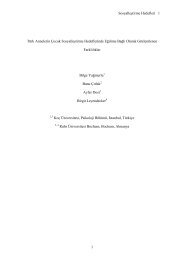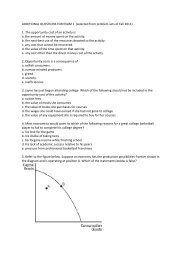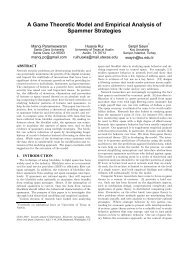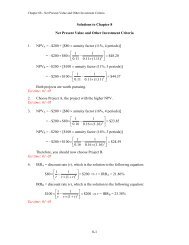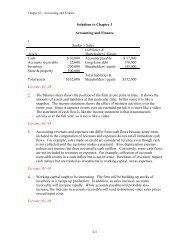1 Pharmacy Discount Competition and Generic Substitution Özden ...
1 Pharmacy Discount Competition and Generic Substitution Özden ...
1 Pharmacy Discount Competition and Generic Substitution Özden ...
You also want an ePaper? Increase the reach of your titles
YUMPU automatically turns print PDFs into web optimized ePapers that Google loves.
<strong>Pharmacy</strong> <strong>Discount</strong> <strong>Competition</strong> <strong>and</strong> <strong>Generic</strong> <strong>Substitution</strong><strong>Özden</strong> Gür Ali 1Burak Çavdaroğlu 21oali@ku.edu.tr, College of Administrative Sciences <strong>and</strong> Economics, Koç University, Istanbul, Turkey2bcavdaroglu@rpi.edu, Decision Sciences <strong>and</strong> Engineering Systems, RPI, Troy, NY, USAABSTRACTWe consider the discounts offered by the manufacturers of prescription drugs topharmacies as an incentive to (not to) substitute the physician’s br<strong>and</strong>ed drug prescriptionwith the generic under the European/ Turkish regulatory environment. The pharmacy channeldiffers substantially from the common retail channel with regulated retail prices <strong>and</strong>consumers who only pay for a fraction of the cost of the goods they receive. For this regulatedchannel we derive equilibrium results for the manufacturer Stackelberg game with twocompeting drugs offering discounts to a pharmacy. We analyze the sensitivity of the results tothe conditions established by the longer term physician <strong>and</strong> patient marketing efforts onbehalf of the drugs. In light of the substantial growth in the number of drugs going off-patent,the insights provided for the br<strong>and</strong>ed <strong>and</strong> generic drug marketing strategies are relevant formanagers in pharmaceutical companies <strong>and</strong> the regulating public officials.Keywords: Health Service, Marketing, Game Theory, <strong>Pharmacy</strong> <strong>Discount</strong>s, <strong>Generic</strong><strong>Substitution</strong>1
1. IntroductionThe pharmaceutical industry plays an important role in the economies of many countries,due to its size, its role in public health <strong>and</strong> public finances. The worldwide pharmaceuticalsales were $808B in 2009 [1]. The pharmaceutical industry spends a large portion of itsrevenues on marketing to the various customers who influence the sale. The industry has avery complicated web of customers: The patient who consumes the drug is a different entitythan the payer, who is typically the government or an insurance company. The physician, <strong>and</strong>sometimes the pharmacist, are gatekeepers who make the product choice decision.Underst<strong>and</strong>ing the incentives in this complex web is important for the players, such as thepharmaceutical companies, the payers, the patients <strong>and</strong> the regulators.The pharmaceutical pull marketing, which aims to generate physician <strong>and</strong> patient dem<strong>and</strong>for specific pharmaceuticals, has received considerable attention in the literature due to itscomplexity, economical impact, <strong>and</strong> the availability of rich data sources. On the other h<strong>and</strong>,the incentives in the distribution channel have not been addressed, partially due to lack ofreliable data.According to the Espín <strong>and</strong> Rovira report [2] funded by the European Commission, mostEuropean countries apply price controls for pharmaceuticals. The report uses the PPRI(Pharmaceutical Pricing <strong>and</strong> Reimbursement Information project) definition for substitutionas "the (m<strong>and</strong>atory or voluntary) capacity of pharmacists to change a br<strong>and</strong> prescription for acheaper (generic) medicine, in order to reduce the cost of prescribed treatments whilemaintaining a st<strong>and</strong>ard", <strong>and</strong> cites that it is practiced in various forms in 18 of the 25 countriescovered by the study. Admissible substitutes for the prescribed drug differ by country.<strong>Generic</strong> versions of the original patent holding drug, which contain the same activeingredients as the original formulation, but they may have been produced by a differentprocess <strong>and</strong> may contain different inactive ingredients, are commonly accepted substitutes.Cizmeci [3] reports based on a survey of pharmacies in Turkey that in the cough <strong>and</strong> coldcategory more than two thirds of the drugs offered a quantity discount to the pharmacist, atleast once over nine months, averaging 17% of the retail price, with a maximum discount ofseventy percent. While the retail price for pharmaceuticals is not regulated in the US, Kina<strong>and</strong> Wosinska [4] report that the generic manufacturers offer the pharmacies discounts toinfluence them to stock their version of the generic. They also state that the pharmacies keepmost of the mark-up for generics, based on the Congressional Budget Office report.2
The pharmacy discounts need to be considered within the context of the patient <strong>and</strong>physician support established for the drugs over time with pull marketing efforts directed atthe physician, (<strong>and</strong> where allowed - the patient). Because the sale of a prescription druginvolves the following steps: The patient presents the medical problem to the physician, whoconsiders the patient's situation <strong>and</strong> the alternative therapies <strong>and</strong> prescribes a medication. Thepatient applies at a pharmacy with the prescription where she typically pays for a smallportion of the retail price <strong>and</strong> receives the prescribed medication. The pharmacist getsreimbursed for the remaining portion of the retail price by the government/ health insuranceagency. The pharmacist can substitute the prescribed medication with another drug from a listof equivalents, or dispense it as prescribed by the physician. The patient decides whether toaccept the dispensed drug <strong>and</strong> pay the out of pocket payment. The physician can respond tothe substitution by the pharmacist by referring his patients to other pharmacies, <strong>and</strong> adissatisfied patient may stop patronizing a pharmacy that substitutes her prescriptions –implying potential loss of revenue for the pharmacist. The Economist reported that one of thereasons for the potential dissatisfaction is a concern for the quality of the authenticity genericdrugs; another one is unwillingness to change the medication that has worked in the past [5].On the other h<strong>and</strong>, the timeframe for the implementation of pharmaceutical discountdecisions is much shorter compared to the physician directed efforts typically involvingphysician visits by sales force or patient directed efforts. Further, physician <strong>and</strong> patientdirected efforts aim at altering their perception of the product <strong>and</strong> their effect is arguably morelasting than the pharmacy discount, whose effect on pharmacy profits disappears once it iswithdrawn or countered by the competitor.The pharmacy is a retailer of pharmaceutical products, <strong>and</strong> coordination of the commonretail channel, where the primary decision variable is pricing <strong>and</strong> other decision variablesinclude advertising, has been studied in the literature extensively [6, 7, 8, 9, 10]. Variousmodels of retailers <strong>and</strong> manufacturers have been analyzed for equilibrium starting withbilateral monopoly <strong>and</strong> increasing in complexity with the number of manufacturers <strong>and</strong>retailers. However, the prescription pharmaceutical distribution channel in Europe includingTurkey is substantially different than the literature since a) the retail price is fixed throughregulation, b) a third party - the physician determines the initial dem<strong>and</strong> with prescriptions,while c) the pharmacist (retailer) can substitute the initial dem<strong>and</strong> within equivalence class,<strong>and</strong> finally d) another party (government or insurance company) pays for the majority of thecost – rather than the consumer.3
Our objective in this paper is to derive insights for the br<strong>and</strong>ed <strong>and</strong> generic drug marketingstrategies in this regulated channel concerning the pharmacy discounts <strong>and</strong> their relationshipwith the physician <strong>and</strong> –where allowed – patient directed sales <strong>and</strong> marketing efforts.For this end, we analyze the pharmacy substitution practice with a model that representsthis regulated nature of the pharmaceutical channel. We formulate a manufacturer Stackelberggame with two drugs <strong>and</strong> a pharmacy under full information assumption, with the followingsteps: First the two drug companies simultaneously <strong>and</strong> non-cooperatively decide on theirown pharmacy discount offers <strong>and</strong> then the pharmacy decides on the substitution rate. Theobjective of all parties is to maximize their profits.In the analysis of this Stackelberg game we identify the equilibrium conditions, discounts<strong>and</strong> profits for both the one way substitution model <strong>and</strong> the two way substitution of identicaldrugs to provide a basis for comparison. The one way substitution model emulates the genericsubstitution where only the more expensive original patent holding, br<strong>and</strong>ed drug can besubstituted with the less expensive generic (but not the other way around). Subsequently weperform sensitivity analysis of the equilibrium results with respect to the conditionsestablished by the longer term physician <strong>and</strong> patient marketing efforts on behalf of the drugs.The rest of the paper is organized as follows. In section 2 we review the literature streamsrelated to the problem. Next, we define the model of the pharmaceutical distribution channel,<strong>and</strong> the game. In section 4 we provide the pharmacist’s profit maximizing decision given thepharmaceutical companies’ discount offers. Section 5 follows with the equilibrium conditions,discounts <strong>and</strong> profits. The penultimate section follows with the sensitivity analysis of theequilibrium results to patient <strong>and</strong> physician pull marketing. We conclude in section 7 withimplications of these results for the marketing mix of the off-patent br<strong>and</strong>ed <strong>and</strong> genericdrugs, limitations of our research <strong>and</strong> further research opportunities.2. LiteratureThere are many papers investigating the effect <strong>and</strong> the influence mechanism of the pullmarketing instruments directed toward the physician <strong>and</strong> to some extent the patient/consumer. The most common physician promotion is “detailing”, where sales representativesof pharmaceutical manufacturers visit physicians to provide information about their products.The detailing activities are typically supplemented by free samples, meetings <strong>and</strong> events,sponsorships for conferences <strong>and</strong> other activities directed toward the physician. Physici<strong>and</strong>irected marketing efforts serve to increase the drug's share among physician prescriptions, as4
well as increasing the portion of patients treated with medication. For example, Gönül et al.(2001) [11] find that detailing <strong>and</strong> sampling have a positive but decreasing effect on physicianprescribing, <strong>and</strong> that the drug price appears to act as a signal of quality. Espín <strong>and</strong> Rovira,(2007) [2] report that physicians are given education <strong>and</strong> incentives by the governments inmany countries to use generics, which can be considered physician directed marketing onbehalf of generic drugs.Patient directed marketing efforts include br<strong>and</strong>ed <strong>and</strong> unbr<strong>and</strong>ed direct-to-consumeradvertising <strong>and</strong> sponsorship of public awareness campaigns. In many countries br<strong>and</strong>edpharmaceutical advertising is not allowed, while sponsorship of public awareness campaignsis permitted [12]. The goals of such efforts are 1) to increase the size of the patient populationthat is aware of the treatment possibility <strong>and</strong> seeks treatment with the specific drug [13], <strong>and</strong>2) to increase the patient's willingness to accept the prescribed/ dispensed drug <strong>and</strong> pay for thepatient out-of-pocket amount [14]. Direct-to-consumer advertising is generally found to havea small <strong>and</strong> positive effect on dem<strong>and</strong>, e.g.[13]. Wosinska <strong>and</strong> Huckman compare the genericdispensing <strong>and</strong> substitution in the mail <strong>and</strong> retail pharmacies in the US [15].The extant research on pharmaceutical marketing mix includes empirical studies, [13, 16]who research the interactions between direct-to-consumer advertising <strong>and</strong> various physici<strong>and</strong>irected marketing efforts. On the theoretical modeling front, Brekke et al. study the effects ofdirect-to-consumer advertising in a prescription drug market with two differentiated br<strong>and</strong>eddrugs in a mathematical model of the rational behavior of the players in the pharmaceuticalsystem [17].On the other h<strong>and</strong>, as the review by Manch<strong>and</strong>a et al. states, the flow of payments betweenthe players in the industry - among them manufacturers, pharmacy benefit managers acting onbehalf of final payer, <strong>and</strong> pharmacists - constitutes an open research area [18]. Gür Ali <strong>and</strong>Mantrala study the profit maximizing behavior of the <strong>Pharmacy</strong> Benefit Manager in the USsystem <strong>and</strong> the effect of the rebates, physician directed pull efforts <strong>and</strong> direct to consumeradvertising [19]. Çavdaroğlu <strong>and</strong> Gür Ali develop a mathematical model of the profitmaximizing pharmacist in Turkey; find that the drug substitution decision is affected by thepharmacy discounts of the pharmaceutical firms relative to each other, suggesting a discountwar [20].Retailer substitution in the operations literature is considered to be a subcategory of theassortment problem, where the retailer is determining the optimum stocking levels of theproducts <strong>and</strong> the substitution rules to be followed [21]. There is a substitution cost associated5
with satisfying the dem<strong>and</strong> with a different product. Most of the studies focus on one-waysubstitutability which means that certain products can be substituted with others in ahierarchical order. In a deterministic setting Drezner et al. developed a variation of thest<strong>and</strong>ard economic order quantity (EOQ) model for the case of two products where product 1can substitute for product 2 at a substitution cost [22]. Parlar <strong>and</strong> Goyal study the two waysubstitution for two products for a generalized version of the single period newsboy problem[23].The substitution in the pharmacy is in the category of retailer driven substitution. Theprimary concern of the pharmacist is the trade-off between the substitution cost <strong>and</strong> theincremental profit margin it receives from dispensing the alternatives. We assumedeterministic dem<strong>and</strong> in order to focus on the manufacturer competition <strong>and</strong> how it is affectedby the patient <strong>and</strong> physician support for the drugs.3. The Model of the Pharmaceutical Channel <strong>and</strong> the <strong>Pharmacy</strong> <strong>Discount</strong> GameIn our mathematical model of the pharmaceutical channel there are two drugs i=1, 2 in thesame equivalence class, which are sold through one pharmacy. The patients come to thepharmacy with a prescription from the physician. The pharmacist can dispense the prescribeddrug or substitute it with the other drug. The patient can pay for the out-of-pocket amount toreceive the dispensed drug, or she can refuse it. A third party e.g., the governmental socialsecurity agency or the health insurance company pays for the rest of the drug.Two-way substitution refers to the case when the pharmacist can substitute either drug foranother. One-way substitution refers to the case when the pharmacist can only substitute themore expensive drug for the less expensive one, but not the other way around, as in thegeneric substitution practiced in Europe, <strong>and</strong> in Turkey [12], where the pharmacist ispermitted to substitute the more expensive original patent holder drug (i=1) with the lessexpensive generic (i=2) in order to reduce public expenditures. The substitutions can result inobjections from physicians <strong>and</strong> patients who feel that the generic drug is not a perfectsubstitute for the prescribed original due to its manufacturing practices or reputation.The retail prices of the drugs are fixed. In many countries, the retail price of the drug is animportant criterion that the government considers in giving the license to sell the drug in thecountry. The pharma company <strong>and</strong> pharmacist decisions we consider in this work take placeafter the retail price has been established, <strong>and</strong> therefore the retail price is exogenous.6
The pharmaceutical manufacturers can offer discounts to the pharmacist as an incentive tosubstitute the competitor's drug or to prevent substitution of their drug.There is a m<strong>and</strong>atory governmental discount where the government receives a specificpercentage discount for the sales that it reimburses. This practice is also referred to asclawback, which is defined as "A system allowing third party payers to recoup (part of the)discounts/rebates granted in a reimbursement system involving various stakeholders, e.g.wholesalers <strong>and</strong> pharmacists.", <strong>and</strong> it is practiced in Austria, Belgium, Italy, Netherl<strong>and</strong>s,Pol<strong>and</strong>, <strong>and</strong> the UK in the European Union [2, 24], as well as in Turkey [12].3.1. The dem<strong>and</strong> functionThe quantity of drug i sold is denoted by q i , which is the number of patients who seektreatment, get a prescription from the physician, get drug i dispensed by the pharmacist <strong>and</strong>pay for the out-of-pocket expense associated with drug i. The pharmacist may dispense drug ieither as prescribed by the physician, or substitute the prescription for drug j with drug i.Thus, we express q i as follows in (1):( ( 1 ) )q = n α − x + α x β(1)i i ij j ji in denotes the total number of patients who seek treatment <strong>and</strong> are prescribed a medicationtreatment by the physician.x ij is the proportion of patients who are dispensed drug j by the pharmacist, given that theyhave a prescription for drug i, i≠j, i, j=1, 2.α i is the proportion of treatment seeking patients who are given a prescription for drug i bythe physician. We assume that the patients are prescribed one of the two drugs: α 1 +α 2 =1.β i is the probability of a patient to pay for the out-of-pocket expense associated with drug i.<strong>and</strong> fill the prescription. We assume that β i is a decreasing function of the out-of-pocketexpenditure for the drug i, since patients –as consumers - are cost sensitive.3.2. The pharmacist’s objective functionBeyond its role in public health, the pharmacy is a retailer <strong>and</strong> a for profit entity.Therefore, while complying with the regulations it will try to maximize its profit from thetransaction of filling the prescription. The pharmacist's profit function, Π p, has threecomponents: 1) the revenues, consisting of the reimbursements from the institutional payer,e.g. government, <strong>and</strong> the out-of-pocket payments from the patients, 2) the cost of goods sold,7
<strong>and</strong> 3) the substitution cost due to expected future revenue loss by dissatisfied physicians <strong>and</strong>/or patients who can take their business elsewhere.Thus, we express the pharmacist’s objective function as follows in (2):⎛ m+dΠ = −⎝ ⎝ 1+m ⎠∑ ⎛ i ⎞q ⎜ p ⎜ ⎟ ∑ ( γ x ) ⎟(2)p i i i iji j≠i⎞⎠p i is the regulated retail price of drug i.m is the regulated pharmacy profit margin.d i is the effective discount rate offered to the pharmacist by manufacturer i, d i e [0, 1]. Itmay be offered in the form of additional quantity with the purchase, or a straight discount,depending on country regulations. Notice that the regulated wholesale price for drug i isexpression p i / (1+m), <strong>and</strong> the discounts decrease the effective wholesale price of the drug.γ i is the cost the pharmacist incurs due to substitution of drug i. It quantifies the current <strong>and</strong>future revenue loss caused by the patient’s or physician’s dissatisfaction because of thesubstitution of drug i. The physician may refer his or her patients to other pharmacies <strong>and</strong>/ ora dissatisfied patient may stop patronizing a pharmacy that substitutes her prescriptions,causing revenue loss for the pharmacist.3.3. The pharmaceutical companies’ objective functionThe pharmaceutical companies try to maximize their profits which consist of the quantitysold times the unit revenue net of the cost of goods sold, discounts given to the pharmacy, <strong>and</strong>the government. The manufacturer i's profit function, Π i , is formulated as follows in (3):Π = qpi i i( 1−d −c −GovDisc)ii1+m(3)Here, c i is the cost of production <strong>and</strong> physician <strong>and</strong> patient directed marketing expressed asa percentage of the regulated wholesale price, <strong>and</strong> GovDisc is the m<strong>and</strong>atory discount that themanufacturer has to give to the government, if it wants to be reimbursed by the governmentsocial security agents (the clawback practice). GovDisc e [0,1].3.4 The gameWe follow the channel competition literature in investigating the pharmacy discounts. Therelevant channel game is the manufacturer Stackelberg with two manufacturers <strong>and</strong> acommon retailer, as there are few large pharmaceutical companies <strong>and</strong> many pharmacies, [7,8, 25]. The manufacturers (pharmaceutical companies) take the retailer's (pharmacist's)8
eaction into account as they simultaneously <strong>and</strong> non-cooperatively set their effectivewholesale price via discounts. In the second step of the game the pharmacist reacts to thesediscount offers by determining the substitution rates. We assume full information.The manufacturers are maximizing their profits as given by (3), while the retailer ismaximizing its profit given by (2). The decision variables of the manufacturers are thepharmacy discounts, d i . The decision variables of the pharmacist are the substitution rates, x ij .4. The Pharmacist’s Optimal Decision Given The Manufacturer’s <strong>Discount</strong> OffersIn the regulated pharmaceutical channel with the described structure, the pharmacist'soptimal substitution rates given the manufacturers' discounts are as follows in (4). Since theobjective function of the pharmacist is linear in terms of the pharmacist's decision variable(x ij ), the optimal pharmacist substitution behavior occurs at the boundaries of the decisionspace.( m d ) ( m d ) ( m)⎧ 1, if p -p 1* ⎪ jβ j+j iβi +i≥ γi+xij= ⎨⎪ ⎩0, otherwise(4)Here, the profit maximizing pharmacist substitutes the prescriptions of one drug with theother, if the difference between the expected marginal profits of the substituting <strong>and</strong> thesubstituted drugs is large enough to overcome the substitution cost. The expected marginalprofit for a drug increases with the discount rate offered by its manufacturer, but it alsoincreases with its retail price, <strong>and</strong> patient probability to fill the prescription.Other things being equal, the higher priced drug has a higher marginal profit for thepharmacist. In fact, to counter balance this incentive to sell higher priced items, manycountries institute lower profit margins (m) for drugs that are in higher retail price buckets[24]. A potential secondary effect of a higher retail price is through the patient fill probability,β: In many countries the out-of-pocket payment increases with the retail price of the drug toalign the patient’s incentives with the payer’s. In others, the patient pays a constant amount(or nothing at all) regardless of the retail price to avoid patient burden <strong>and</strong> involvement inmedical decision making. When the patient out-of-pocket payment amount is determined soas to align the patient <strong>and</strong> payer incentives, for example as a percentage of the retail price, ahigher retail price would reduce the patient’s fill probability due to price sensitivity. On theother h<strong>and</strong>, in the presence of fixed patient co-payment amounts regardless of retail price,9
other things being equal, higher priced drug does not necessarily have a lower patient fillprobability.5. The Equilibrium ResultsIn this section we consider the equilibrium discounting decisions of the pharmaceuticalcompanies according to the manufacturer Stackelberg game. In this two stage game, first themanufacturers simultaneously announce their discount offers, disc i , anticipating the rationaldecision of the pharmacist as derived in (4), in knowledge of each other's retail price, p i ,prescription share, α i , patient's probability to fill the prescription by paying for the out-ofpocketexpense, β i , substitution cost, γ i , cost of production <strong>and</strong> marketing, c i, ; as well as thepharmacy margin, m, <strong>and</strong> m<strong>and</strong>atory government discount, GovDisc, which are set by thegovernment. Then they observe the substitution decisions by the pharmacist. If all the playersare acting in accordance with the Nash equilibrium, no one has an incentive to unilaterallydeviate <strong>and</strong> take another action. The equilibrium, if it exists, will occur at the intersection ofthe best response correspondences of both companies.Of course, the α i , β i , γ i , c i parameters are functions of the long term sales <strong>and</strong> marketingstrategy of drug i. However, they are constants for the short term pharmacy discount decision.To facilitate the analysis we define the power of pharmaceutical company i, POW i , as theexpected profit that the pharmacist could derive by dispensing drug i to a patient, disregardingthe substitution costs.⎛m+di⎞POWi = βipi⎜ ⎟(5)⎝ 1+m ⎠POW i is a linear function of the discount by the pharmaceutical company i. Note that themaximum discount the company i can give while not losing money is 1-c i -GovDisc. Wedenote the company’s power at this discount rate by POW max i, <strong>and</strong> the lowest power byPOW min i which corresponds to no discount by drug i.POWPOW⎛ GovDisc + ci⎞= β p ⎜1−⎟⎝ (1 + m)⎠maxi i i⎛ m ⎞= β p ⎜ ⎟⎝1+m ⎠mini i i(6)(7)10
5.1. Best response correspondenceThe best response correspondence characterizes the best possible discounting decision ofcompany i in response to POW j , which is a direct result of the discount decision of thecompetitor j.BRC ( POW ) = arg max Π ( z , POW )(8)i j i i jmin maxzi∈[Pow i ,Pow i ]We substitute the optimal substitution rates derived in the previous section into thecompany's profit function (3), <strong>and</strong> maximize it with respect to the company's own power toidentify the best response correspondence for the competitor's power resulting from itsdiscount rate, as shown in Table 1.Interpreting the best responses in Table 1, if the pharmacist’s expected profit fromdispensing a patient drug i cannot match the expected profit from substituting it with drug jeven when the manufacturer of drug i discounts to the maximum amount it can afford, thendrug i cannot stay in business (Condition 1). It does not matter what discount it offers, all itsprescriptions will be substituted.Interestingly, the best response can be not to discount under three very different situations:a) when neither of the competing drugs can incentivize the pharmacist to substitute the other(Condition 3), b) when the discount required for substituting the competitor is too highconsidering the share of physician prescriptions that the drug has (Condition 5), or c) whenthe drug provides enough expected profit for the pharmacist to substitute the competitor evenwithout discounting (Condition 6).When the pharmacist’s expected profit from dispensing the competitor is large enough tothreaten the substitution of a drug (Condition 2), the best response is to discount enough toreduce the difference between the expected profits to a level that is equal to the substitutioncost (i.e., pharmacist’s expected loss of business due to substitution).When the drug has a low share of physician prescriptions, <strong>and</strong> can increase its profitabilityfor the pharmacist to a level that exceeds the competitor’s profitability <strong>and</strong> covers for thesubstitution cost (Condition 4), the best response is to discount enough to ensure substitutionof the competitor. This condition is likely to be satisfied with a high retail price <strong>and</strong> highpatient willingness to fill the prescription for the drug, <strong>and</strong> a low substitution cost for thecompetitor.11
Increasing power of drug i1maxi j iCondition Interpretation BRC i (POW j ) d i corresponding to BRC i (POW j )POW < POW − γ Cannot defend against substitution [2max minPOWi ≥ POWj −γi≥ POWi3 mini j i45POW > POW − γ , <strong>and</strong>POW < POW + γmaxi j jPOW > POW + αψ > POWPOW −POW− ( γ + ε )αi POWj + γj> POWiPOW −POW− ( γ + ε )αi>POWmaxi j jmaxi− POWj + γi6minPOWi > POWj + γjCan defend against substitution bydiscountingCan defend itself againstsubstitution without discountingbut cannot substitute the otherCan substitute the other drug bydiscounting <strong>and</strong> its prescriptionshare is not too high to make itunprofitableCan substitute the other bydiscounting but the prescriptionshare is too high to make itprofitableCan substitute the other drugwithout discountingPOW , POW ] [ 0,1− GovDisc − ci]miniPOWmaxip β( 1+m)j j ij− γi( dj− m)+ m+piβi piβiminPOWi0POW γ εp βj jjj+j+ ( dj−m)+ m−piβi pi iminPOWi0minPOWi0γ( γ + ε)( 1+m)βTable 1. Best response correspondence for drug i given drug j’s discount.12
5.2. Two way substitution of symmetric drugsBefore we analyze the pharmaceutical channel under the generic substitution practice, weconsider a simpler model version with symmetric products, <strong>and</strong> no m<strong>and</strong>atory governmentdiscount (GovDisc=0). The two symmetric drugs have the same retail price, cost, prescriptionshare, <strong>and</strong> patient probability to fill. Consequently POW max , POW min , c <strong>and</strong> γ values of thetwo competing drugs are the same <strong>and</strong> will be used without indices.When there is no substitution cost (γ=0) the profit maximizing pharmacist simplysubstitutes all prescriptions in favor of the drug that provides marginally more profit, which* *results in a discount war, with each drug reducing its profit to zero. POW 1 = POW 2 = POW max ,<strong>and</strong> π * 1 = 0, π * 2 = 0.Introducing a substitution cost (γ>0) allows the manufacturers to keep some of the profits.When the difference between the maximum <strong>and</strong> minimum profitability of the drugs in the eyeof the pharmacist is large enough to overcome the substitution cost; i.e., POW max - POW min >γ,* *the equilibrium is at POW 1 = POW 2 = POW max -γ, since both drugs are defending themselvesagainst being substituted. In this case the manufacturer profits are π * 1 =π * 2 =0.5 nγ. Otherwise,i.e., when POW max - POW min ≤γ ; there is no possibility of substitution <strong>and</strong> neither manufacturerdiscounts. Hence they obtain the regulated profit margins: π * 1 =π * 2 =0.5 n POW max /(1+m). Inother words, the substitution cost works to the manufacturers’ advantage under the symmetricproduct case. The implication for the pharmaceutical companies’ marketing strategy isbuilding br<strong>and</strong> awareness to increase the substitution cost in order to escape the discountcompetition.5.3. One way substitution of asymmetric drugs: generic substitutionWe now analyze the generic substitution practice by restricting the substitutions in themodel characterized by the equations (1) through (3) such that the br<strong>and</strong>ed drug can besubstituted with the generic, but not the other way around. We use subscript br for the br<strong>and</strong>eddrug <strong>and</strong> gen for the generic drug, hence the pharmacist's only decision variable in this sectionis x br gen , while x gen br = 0. The br<strong>and</strong>ed drug is the original patent holder drug, <strong>and</strong> its generichas a lower retail price: (p br >p gen ).There exist three types of equilibriums such that neither pharmaceutical company can bebetter off by unilaterally changing its discount rate: <strong>Substitution</strong> without <strong>Discount</strong>,<strong>Substitution</strong> with <strong>Discount</strong>, <strong>and</strong> No <strong>Discount</strong> – No <strong>Substitution</strong>. In Table 2 we summarize the13
Equilibrium Condition Equilibrium Powers Equilibrium <strong>Discount</strong> rates Manufacturer Profits1. <strong>Substitution</strong>without <strong>Discount</strong>minmax* min maxPOWgen > POWbr + γbrPOWbr = ⎡ ⎣ POWbr , POW ⎤br ⎦POW= POW* mingengen( )**dbr= ⎡⎣0, 1−GovDisc−cbr⎤⎦πbr= 0*dgen= 0*( 1−cgen−GovDisc)πgen = n βgen pgen1+m2. <strong>Substitution</strong>with <strong>Discount</strong>3. No <strong>Discount</strong> –no <strong>Substitution</strong>POW ≤ POW + γ ≤ POWα<strong>and</strong>genmin max maxgen br br genPOW≤−POW−γmaxmaxgen br brmaxmax( POWgen− POWbr)POW > POW γmin maxbr gen-brPOW= POW* maxbrbrPOW POW γ εPOWPOWmax= + + ( POW + γ + ε)( 1+m)* maxgen br br= POW* minbrbr= POW* mingengend = 1−GovDisc−cddd*br*gen*br*gengenbrbr br= − m πp β= 0= 0genπ = 0,*br⎛1−cgen− GovDisc+m⎞= nβp ⎜ ⎟⎝ 1+m ⎠*gen gen genmax( brγbrε)− n POW + +π = nα β p*br br br brπ = nα β*gen gen gen gen( 1−c−GovDisc)pbr1+m( 1−cgen−GovDisc)Table 2. Equilibrium conditions, powers, discount rates <strong>and</strong> manufacturer profits for one way substitution from br<strong>and</strong>ed to its genericversion.1+m14
conditions, <strong>and</strong> the powers, discounts <strong>and</strong> profits of the br<strong>and</strong>ed <strong>and</strong> the generic drugmanufacturers, associated with each equilibrium.Equilibrium 1. <strong>Substitution</strong> without <strong>Discount</strong>: For this equilibrium to reign, thepharmacist’s expected profit from substituting the br<strong>and</strong>ed prescription with the genericversion should be higher than the expected profit from dispensing the prescribed br<strong>and</strong>ed drug<strong>and</strong> make up for the substitution cost; even when the br<strong>and</strong> is discounting to the maximum<strong>and</strong> the generic drug is not discounting, i.e.; POW min gen > POW max br +γ br . In this case thebr<strong>and</strong>ed drug is fully substituted with the generic without discounts. The generic companyachieves maximum profits. This is an unlikely scenario, as the retail price of the br<strong>and</strong> ishigher than the generic’s: p br >p gen ; unless the patients refuse the br<strong>and</strong>ed drug <strong>and</strong> fill thegeneric prescriptions, i.e. β gen >>β br .Equilibrium 2. <strong>Substitution</strong> with <strong>Discount</strong>: This equilibrium exists when thepharmacist’s expected profit from substituting the prescribed br<strong>and</strong>ed drug with the genericdrug, including the substitution cost, can exceed the expected profits from dispensing theprescribed br<strong>and</strong>ed drug, even when the br<strong>and</strong>ed drug is discounting to the maximum level itcan afford. Additionally, the generic drug should have a low enough share of the prescriptionsmaking it worthwhile for it to sacrifice part of the profit margin on its own prescriptions toincrease its share of the dispensed drugs. In this case, the generic company discounts enoughto match the pharmacist's expected profits from the maximally discounted br<strong>and</strong>ed drug <strong>and</strong>to make up for the substitution cost <strong>and</strong> an additional epsilon to induce substitution, <strong>and</strong>retains the rest of the profits. The pharmacist dispenses the generic drug for the patients withbr<strong>and</strong>ed <strong>and</strong> generic prescriptions.The higher the substitution cost of the br<strong>and</strong>, the higher the discount that the generic has togive, <strong>and</strong> also the lower the maximum share of physician prescriptions the generic can havefor the conditions of this equilibrium to hold.Equilibrium 3. No <strong>Discount</strong> – No <strong>Substitution</strong>: For this equilibrium to hold, theundiscounted br<strong>and</strong>ed drug has to be more profitable to the pharmacist than the generic drugat the maximum discount it can afford. Under this condition the br<strong>and</strong> retains all the dem<strong>and</strong>it gets from prescriptions without discounting. Both the companies make profits based on theregulated margins. The pharmacist does not get additional profits due to discounts.The regulated profit margin without discounts is higher for the br<strong>and</strong>ed drug due to itshigher retail price. Other factors that can amplify this effect <strong>and</strong> help bring about this15
equilibrium condition are a) patient out-of-pocket payments not being aligned with retail price– such as patient co-payments being constant regardless of the drug’s retail price, b) high costof goods sold for the generic company preventing it from discounting sharply – such asinefficient production process or physician directed marketing expenses – as in the case of“br<strong>and</strong>ed generics”, <strong>and</strong> c) high government discount requirements reducing potential fordiscounting.No equilibrium: Notice that when the maximum power of the generic is between themaximum <strong>and</strong> the minimum powers of the br<strong>and</strong>ed drug, i.e., accounting for the substitutioncost POW min br ≤POW max gen -γ br ≤ POW max br , no equilibrium exists. Because either drug can bebetter off by changing its discount rate in any combination of discounts. For example: if thegeneric gives maximal discount, the br<strong>and</strong>ed drug can match its power less substitution cost<strong>and</strong> prevent substitution. At this point the generic is better off not discounting because it isgiving discounts without gaining share. If the generic does not discount the br<strong>and</strong> is better offnot discounting either. However, if the br<strong>and</strong> does not discount the generic is better offdiscounting <strong>and</strong> inducing substitution. The same argument can be made for the case whenPOWPOW ≤ POW + γ ≤ POW , <strong>and</strong> α >min max maxgen br br gen gen−POW−γmaxmaxgen br brmaxmax( POWgen− POWbr).6. Sensitivity of the <strong>Discount</strong> Equilibrium Results to Patient <strong>and</strong> Physician PullMarketingIn this section we analyze the sensitivity of the discount equilibrium results to results to theconditions established by the longer term physician <strong>and</strong> patient marketing efforts on behalf ofthe drugs.The physician goodwill stock for drug i, [26] is maintained <strong>and</strong> increased over time withphysician directed marketing efforts on behalf of drug i. Many studies have shown a positiveeffect of physician directed marketing efforts, such as detailing <strong>and</strong> sampling, on physicianprescriptions for the br<strong>and</strong>, see for example [11, 13, 27]. Hellerstein’s empirical study reportsthat physicians are important agents in determining whether their patients receive br<strong>and</strong>ed orgeneric drugs [28].While they are not the only factor contributing to the goodwill stock for the drug, physici<strong>and</strong>irected sales <strong>and</strong> marketing activities are controlled by the company <strong>and</strong> hence are ofinterest. Interestingly, many manufacturers of drugs that do not hold the original patent do16
engage in br<strong>and</strong> building activities – these are called “br<strong>and</strong>ed generics”. The Economistreported that this new trend in emerging markets builds in part on “the fear that unknownproducts might be of fake or dubious quality” [5].The physician goodwill stock for generic drugs can be increased over time throughphysician education <strong>and</strong> incentives for generic use – provided by the government. Espin <strong>and</strong>Rovira categorize the physician incentives for “good prescribing practices” that are applied inEurope as financial (remuneration for physicians, coercive <strong>and</strong> indicative budgets, nonfinancial(information, education/ training, cost effectiveness <strong>and</strong> therapeutic guidelines) <strong>and</strong>mixed incentives [2]. Similarly, the sales forces of <strong>Pharmacy</strong> Benefit Managers (PBM) in theUSA detail physicians about generic use, <strong>and</strong> provide them with incentives to prescribegenerics [19].A high physician directed effort marketing strategy on behalf of drug i will result in thefollowing results in the medium to long run, compared to a low physician directed effortmarketing strategy:• higher physician goodwill stock for drug i , <strong>and</strong> therefore higher number of patientswith prescription therapy, n, higher share of physician prescriptions, α i , <strong>and</strong> highersubstitution cost, γ i , as well as• higher cost, c i .Patient goodwill stock for a drug, can be maintained <strong>and</strong> increased over time by direct topatient advertising for the br<strong>and</strong> - where permitted, <strong>and</strong> by public awareness campaignspromoting the use of generic drugs for the generic.In the USA, where direct to consumer advertising is allowed, the price for the br<strong>and</strong>edversion can be multiples of the generic version, thanks to the br<strong>and</strong> awareness of patients.(See for example Zocor, Prozac, or Prilosec selling for three to ten times the price of theirgeneric version – source: drugstore.com, accessed July 10, 2009). Patient directed marketingefforts can also be in the form of generic awareness programs, public campaigns to increaseacceptance of generic medication by the patients. Prevention magazine surveys of consumersindicated that consumer advertising of pharmaceuticals increased the consumer's br<strong>and</strong>awareness <strong>and</strong> willingness to pay for the medication [29].A high patient directed effort marketing strategy on behalf of drug i will result in thefollowing results in the medium to long run, compared to a low patient directed effortmarketing strategy:17
• higher patient goodwill stock for drug i, <strong>and</strong> therefore higher patient willingness to fillthe br<strong>and</strong> prescription β i , <strong>and</strong> higher substitution cost γ i ,• but also higher cost, c i .Other things being equal, a high physician directed effort marketing strategy by thebr<strong>and</strong>ed original patent holding drug, compared to the low physician directed effort marketingstrategy, will result in the following: a) a higher substitution cost for the generic to overcometo compel the pharmacist to substitute the br<strong>and</strong>, b) no change to the pharmacist’s expectedprofit from dispensing the br<strong>and</strong> to the patient (POW br ) at the same discount rate; c) a lowermaximum discount rate that the br<strong>and</strong> can offer while still staying profitable (1-c br -GovDisc);d) larger market size due to more patients getting prescriptions.Similarly, due to the high patient directed effort strategy, compared to the low patientdirected effort marketing strategy, other things being equal, a) The generic faces a highersubstitution cost to overcome to bring the pharmacist to substitute the br<strong>and</strong>, b) thepharmacist gets a higher expected profit from dispensing the br<strong>and</strong> to the patient (POW br ) forthe same discount rate; c) however, the maximum discount rate that the br<strong>and</strong> can offer whilestill staying profitable (1-c br -GovDisc) goes down.Therefore, the net effect of the high physician <strong>and</strong> patient directed marketing strategies onthe pharmacy discount equilibriums depends on the cost effectiveness of the marketingefforts. Only if these efforts are effective <strong>and</strong> cost efficient enough, then the conditions for the“No <strong>Discount</strong> – No <strong>Substitution</strong>” equilibrium will be established. Interestingly, the genericwill benefit from these efforts by enjoying the larger market size n <strong>and</strong> undiscounted profitmargins.On the other h<strong>and</strong>, a “br<strong>and</strong>ed generic” drug marketing strategy that includes intensephysician directed efforts, will have the effect of increasing α gen , n <strong>and</strong> c gen ; thereby changingthe relative powers of the drugs away from conditions for the “<strong>Substitution</strong> with <strong>Discount</strong>”equilibrium, as high physician share makes it unprofitable for the generic to give pharmacydiscounts, <strong>and</strong> toward the “no <strong>Discount</strong>, No <strong>Substitution</strong>” equilibrium.The generic drug clearly st<strong>and</strong>s to gain from government campaigns encouraging the useof generic drugs at the physician <strong>and</strong> patient will increase the β gen <strong>and</strong> α gen , without affectingthe generic cost c gen .18
7. Conclusions, Managerial Implications, <strong>and</strong> LimitationsIn this paper we have analyzed the pharmacy discount competition that ensues when thepharmacist can substitute the drug prescribed by the physician with an equivalent drug, inorder to gain insights into viable marketing strategies for the pharmaceutical companies ofbr<strong>and</strong>ed <strong>and</strong> generic drugs, <strong>and</strong> the effect of generic awareness programs <strong>and</strong> m<strong>and</strong>atorygovernment discounts.Specifically, we have analyzed the manufacturer Stackelberg game with twopharmaceutical companies with equivalent drugs <strong>and</strong> one pharmacist, in the regulatedpharmaceutical distribution channel that is markedly different from the common channelanalyzed in the literature since a) the retail price is fixed, b) a third party - the physici<strong>and</strong>etermines the initial dem<strong>and</strong> with prescriptions, while c) the pharmacist (retailer) cansubstitute the initial dem<strong>and</strong> within equivalence class, <strong>and</strong> finally d) another party(government or insurance company) pays for the majority of the cost – rather than theconsumer. We have made the common assumptions of non-cooperative competition under fullknowledge with deterministic responses to arrive at an analytically tractable model to supportdrawing strategic insights.Analysis of symmetric products under two way substitution showed that in the absence of asubstitution cost, the pharmacist gets all the profits as the pharmaceutical companies discountmaximally under intense competition - as in the common retail channel. Existence of asubstitution cost due to physician <strong>and</strong> patient goodwill stock for the drugs allows them tokeep some portion of the profits. The implication for the pharma companies’ marketingstrategy is that drugs that can be substituted by the pharmacist need to build physician <strong>and</strong>patient goodwill stock – or br<strong>and</strong> awareness - through marketing efforts in order to escape thediscount competition.Allowing only one way substitution from the more expensive br<strong>and</strong>ed drug to its generic,the model represents the salient characteristics of the pharmaceutical channel with genericsubstitution which is practiced in most European countries, as well as in Turkey. We find thatdepending on the relative retail prices <strong>and</strong> physician <strong>and</strong> patient support for the drugs thegame can result in one of the following three equilibriums in the order of increasing power ofthe original br<strong>and</strong>ed drug versus the generic: 1. <strong>Substitution</strong> without <strong>Discount</strong>, 2. <strong>Substitution</strong>with <strong>Discount</strong>, <strong>and</strong> 3. No <strong>Discount</strong> – No <strong>Substitution</strong>.Based on the generic substitution pharmacy discount equilibrium analysis results, the br<strong>and</strong>has to make sure that the conditions for the “No discount – No substitution” pharmacy19
discount equilibrium are satisfied, in order to make any profits. An obvious implication forthe br<strong>and</strong>ed drug marketing strategy is emphasis on high retail price during the drug licensingprocess to ensure high profits for the pharmacist. Given that the retail prices are regulatedafter licensing, the br<strong>and</strong> needs to find the optimal level of physician <strong>and</strong> patient directedefforts, to build a substitution cost just high enough to escape the discounting <strong>and</strong> substitutionequilibrium, while not increasing its costs to a level where it cannot pose a credible threat tocounter the generic’s discount offers. Of course, higher costs also have the effect of reducingthe profit margin. Interestingly, the classical sales force sizing applications do not considerthe effect of detailing on the pharmacy substitution cost. Similarly, whether the patientdirected efforts are worth undertaking should also be evaluated with respect to the effect onthe pharmacy discount equilibrium.Interestingly, the generic drug only discounts in the equilibrium if it does not have a highshare of the physician prescriptions, <strong>and</strong> if the patients do not have a much higher fill rate ofthe generic than the br<strong>and</strong>ed drug. This suggests that the generic drug’s marketing strategyshould exclude heavy physician directed efforts if it is focusing on pharmacy discounts. Whenthe generic cannot discount enough to make substitution attractive for the pharmacist it cannotachieve substitution, which is the case under the No <strong>Discount</strong> – No <strong>Substitution</strong> equilibrium.In this case the generic needs to engage in a “br<strong>and</strong>ed generic” strategy to grow. According toIMS Health, 15% to 20% of the off-patent drug sales in Germany <strong>and</strong> France in 2008 were bythe “br<strong>and</strong>ed generics”.From the public point of view, the pharmacy discounts are funds that are channeled to thepharmacists due to their power to influence drug choices between drugs that are deemed to beequivalent. The practice of keeping the prescription drugs behind the counter makes sure thatthe patient is protected from making inappropriate choices with potentially severeconsequences; on the other h<strong>and</strong>, it also has the effect of keeping the patient in the dark aboutthe prices <strong>and</strong> copayment requirements of drugs that are deemed equivalent to the prescribeddrug.Interestingly, payer/government efforts to increase patient acceptance of generic drugs –<strong>and</strong> refusal of costly br<strong>and</strong>s will have the effect of preparing the conditions for the“<strong>Substitution</strong> without <strong>Discount</strong>” equilibrium. Note that if the physicians are largely unawareof the drug therapy choices <strong>and</strong> their advantages / disadvantages, public interest may be inkeeping the br<strong>and</strong>ed drug in business for it to continue detailing the physicians <strong>and</strong> increasing20
the number of patients given drug treatment. Otherwise, the cost savings from genericsubstitution are going to be more important.Further, other things being equal, increasing the m<strong>and</strong>atory governmental discountrequirements reduces the equilibrium discount rates under the “<strong>Substitution</strong> with <strong>Discount</strong>”equilibrium, <strong>and</strong> makes it easier for the non-discount equilibrium conditions to hold.M<strong>and</strong>atory governmental discounts (clawback), while reducing the cost to the governmentmay push the generic to engage in br<strong>and</strong>ing activities to grow.One of the limitations of our analysis is the assumption of homogeneity for patients,physicians <strong>and</strong> pharmacists. In reality, price sensitivity, br<strong>and</strong> awareness <strong>and</strong> value varyacross patients; the value attributed to each drug <strong>and</strong> the response to physician directedmarketing efforts vary across physicians; <strong>and</strong> similarly the pharmacists differ in theirperception of substitution costs. Consequently, the market response to a given set of discountswill not be full or no substitution. In fact, just as the pharmaceutical companies segment thephysicians <strong>and</strong> target their efforts, pharmacists could also segment the physicians <strong>and</strong> patientsaccording to the expected substitution cost, <strong>and</strong> devise an optimal substitution policy for eachsegment. A tactical model that takes such segmentation of physicians <strong>and</strong> patients intoaccount could identify strategies yielding higher profits for pharma companies - while,naturally, complicating the model <strong>and</strong> analysis further.The insights developed in this work show that the development of competitive strategies inthe pharmaceutical distribution channel has to consider the patient <strong>and</strong> physician support forthe drug that is established over time with the contribution of pull marketing efforts. This callsfor a coordination of the pull <strong>and</strong> push marketing efforts in pharmaceutical companies. Theresults also point out how the government can influence the strategies of the pharmaceuticalcompanies.21
REFERENCES[1] IMS Health, Global pharmaceutical sales 2002-2009, viewed August 11, 2010,http://www.imshealth.com/portal/site/imshealth/menuitem.a46c6d4df3db4b3d88f611019418c22a/?vgnextoid=e599410b6c718210VgnVCM100000ed152ca2RCRD&cpsextcurrchannel=1 (2010)[2] Espín, J., Rovira R. , Analysis of differences <strong>and</strong> commonalities in pricing <strong>and</strong>reimbursement systems in Europe,http://ec.europa.eu/enterprise/phabiocom/comp_pf_en.htm, accessed May 2008. (2007)[3] Çizmeci B. , Pharmacist’s substitution strategy in the presence of manufacturer quantitydiscounts <strong>and</strong> an empirical study on the cost effects of Rx-To-OTC switch in Turkey.M.S. thesis, Koc University, Turkey, (2008)[4] Kina, S.H:, <strong>and</strong> Wosinska, M., Pharmaceutical pricing, in H<strong>and</strong>book of PricingResearch in Marketing, Rao, V. R. (Editor), pp 488-511, Edwar Elgar Publishing(2009)[5] The Economist, Friends for life, Accessed 21.8.2009http://www.economist.com/businessfinance/PrinterFriendly.cfm?story_id=14177559,August 9, 2009 (2009).[6] Jeul<strong>and</strong>, A. P., <strong>and</strong> Shugan, S.M., Managing channel profits, Marketing Science, 2 (3)239-272 (1983)[7] McGuire, T., <strong>and</strong> R. Staelin. An industry equilibrium analysis of downstream verticalintegration. Marketing Science, 2, 161–192 (1983)[8] Choi, S. C. Price, <strong>Competition</strong> in a channel structure with a common retailer.Marketing Science. 10, 271–296 (1991)[9] Jorgensen, S., <strong>and</strong> Zaccour, G., Equilibrium pricing <strong>and</strong> advertising strategies in amarketing channel, Journal Of Optimization Theory And Applications, 102(1) 111 125(1999)[10] Huang, Z., <strong>and</strong> Li, S. X., Co-op advertising models in manufacturer-retailer supplychains: A game theory approach, European Journal of Operational Research, 135 (3)527-544 (2001)[11] Gönül, F. F., Carter F., Petrova E., <strong>and</strong> Srinivasan K. Promotion of prescription drugs<strong>and</strong> its impact on physicians’ choice behavior. Journal of Marketing, 65 (3), 79 – 90(2001)22
[12] Kanavos, P., Üstel, İ., <strong>and</strong> Costa-Font J., Pharmaceutical reimbursement policy inTurkey, Sağlıkta Umut Vakfı (SUVAK)Yayınları, viewed 27 April 2007, (2005)[13] Narayanan, S., Desiraju, R., <strong>and</strong> Chintagunta, P.K., Return on investment implicationsfor pharmaceutical promotional expenditures: The role of marketing-mix interactions.Journal of Marketing 68 (4), 90-105 (2004)[14] Wosinska, M., Direct-to-consumer advertising <strong>and</strong> drug therapy compliance, Journal ofMarketing Research, 42 (3), 323-332 (2005)[15] Wosinska, M., <strong>and</strong> Huckman. R.S., <strong>Generic</strong> dispensing <strong>and</strong> substitution in mail <strong>and</strong>retail pharmacies. Health Affairs, 23, 409-416 (2004)[16] Wittink, Dick R, Analysis of ROI for pharmaceutical promotions (ARPP), viewedSeptember 18, 2002 [available at http://www.vioworks.com/clients/amp] (2002)[17] Brekke, K. R., Kuhn, M., Direct to consumer advertising in pharmaceutical markets.Journal of Health Economics. 25 (1), 102-130 (2006)[18] Manch<strong>and</strong>a, P., Wittink, A. et al., Underst<strong>and</strong>ing firm, physician, <strong>and</strong> consumer choicebehavior in the pharmaceutical industry. Marketing Letters, 16 (3-4), 293-308 (2005)[19] Gür Ali Ö, Mantrala M, Pharma Rebates, <strong>Pharmacy</strong> Benefit Managers <strong>and</strong> EmployerOutcomes, Health Care Management Science, forthcoming (2010).[20] Çavdaroğlu, B., Gür Ali, Ö. Profit maximizing pharmacy decision <strong>and</strong> pharmacydiscounts in Turkey. Proceedings of the 14 th Euroma Conference (2007)[21] Pentico, D.W. The assortment problem: A survey. European Journal of OperationalResearch 190 (2), 295-309 (2007)[22] Drezner, Z., Gurnani, H., <strong>and</strong> Pasternack, B.A, An EOQ model with substitutionsbetween products. Journal of the Operational Research Society. 46 (7) 887–891 (1995)[23] Parlar, M., <strong>and</strong> Goyal, S., Optimal ordering decisions for two substitutable productswith stochastic dem<strong>and</strong>s. Operations Research, 10, 96–100 (1984)[24] Ess, S. M., Schneeweiss, S., <strong>and</strong> Szucs T. D., European healthcare policies forcontrolling drug expenditures. Pharmacoeconomics, 21 (2), 89-103 (2003)[25] Lee, E., <strong>and</strong> Staelin R., Vertical strategic interaction: Implications for channel pricingstrategy. Marketing Science, 16(3) 185–207 (1997)[26] Nerlove, M., <strong>and</strong> Arrow, K. J., Optimal advertising policy under dynamic conditions.Economica, 29, 129–142 (1962)23
[27] Mizik, N., <strong>and</strong> Jacobson R., Are physicians easy marks? Quantifying the effects ofdetailing <strong>and</strong> sampling on new prescriptions. Management Science, 50 (2), 1704-1715(2004)[28] Hellerstein, J., The importance of the physician in the generic versus trade-nameprescription decision. RAND Journal of Economics, 29 (1), 108 – 136 (1998)[29] Prevention Magazine Report, Fifth annual survey: consumer reaction to DTCadvertising of prescription medicines, Emmaus, PA (2004)24


